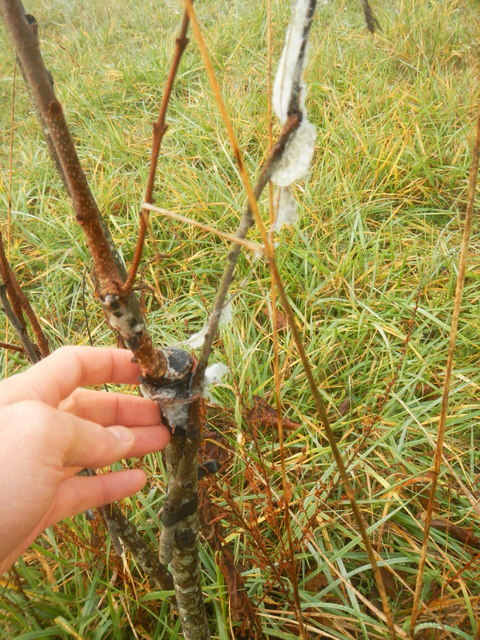I took advantage of a foggy morning to take photos of about 7 persimmon trees I grafted, one from last year (2014) and the rest from this year. I’m trying to make sense of why some grafts grew much better than others. Larger rootstocks seem to push more vigorous growth, but I’m starting to think that it also makes a big difference if grafts are placed lower on the stock and on relatively larger diameter portions of the stock. I’m thinking mainly just about persimmons here, but I suppose if my hypothesis is true it would apply broadly. The hypothesis – I don’t mean to suggest this is anything novel; for all I know, this is common knowledge that’s simply new to my thinking – is based in part on something Alan shared about pruning and considering the diameter ratio at the point of attachment and partly on Bill Reid’s advice on his fantastic pecan blog to place pecan grafts no higher than halfway up the stock (i.e. to remove at least half of the stock.) Basically, my hypothesis is that the vigor with which a graft grows is greater if more of the stock is removed and the graft is place lower on the stock, and it’s especially greater if there aren’t any significant reductions in the diameter of the stock between ground level and where the graft is placed (especially places where the stock forked or branched heavily and the continuing leader is significantly smaller than below that branching point.) I’m curious to hear if this makes sense or seems likely or jives with your experience or…
I should perhaps note a couple things that are a little different about my persimmons. First, most of my rootstocks and all of the ones in these photos are volunteer native persimmons in and around my pastures. I think it’s possible that the roots are 10 or 20 or 30 years old or more. It seems like one can mow down persimmon trees and they’ll just keep coming back year after year after year, so I have no idea how many times that happened with these trees. I mostly let them grow for 2 or 3 years (without mowing) before grafting them. Secondly, almost every one of these trees seems to get attacked by borers (I guess persimmon borers) every year (if I remember correctly, in the spring) that bore in just above ground level, sometimes up to about 5 holes (about 1/2" or more in diameter) per little tree. Sometimes it looks like the trees have been damaged so badly that they won’t survive, but they mostly seem to survive anyway. I wonder if they aren’t causing major differences in relative vigor, though.
All grafts are from this year and all are Asian, except where noted otherwise. A close-up of the graft union area follows a photo of each tree. All grafts were various forms of bark grafts.
Number 1. This one grew well. The stock was relatively large. I placed the graft at a point where the stem was still fairly large.


Number 2. This is a native on native. It grew well enough that I think it will survive but not with near the vigor of some other grafts. The stock was average size. I placed the graft rather high where the stem wasn’t much larger than my scion.


Number 3. I grafted this tree on 3 separate stems (just for back-up in case they didn’t all take or survive, but they all have so far.) All 3 grafts grew pretty well. All three grafts were placed on relatively large diameter wood.




Number 4. This is the only other native. It was grafted the lowest onto by far the largest diameter stock. I grafted on opposite sides of the stock. Both sides grew vigorously, but one side broke out before I staked it well. It didn’t branch like some of the Asians, but it had by far the most vertical growth.


Number 5. This is a hybrid. It barely leafed out but it did minimally survive/stay green for at least two or three months. It might even be barely alive now, but if it’s not dead already, I expect it to die before it leafs out next spring. I placed the grafts relatively high on the stocks.


Number 6. This is the only tree among these photos that I grafted a year earlier than the others. It has looked reasonably healthy, but it’s put on very little growth, even after two years. I placed the graft quite high, and there’s a major reduction in stem size well below the graft union.

I’ll continue below.





